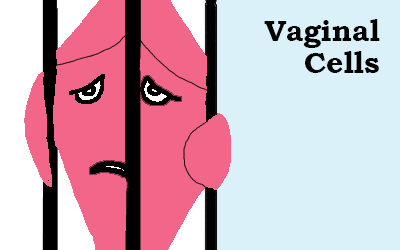A normal vaginal smear has a collection of cells on it, with the majority being epithelial cells. A vaginal smear also contains leukocytes, erythrocytes and bacteria, plus a handful of other cells and/or organisms that didn’t belong there in the first place.
There are three main types of vaginal epithelial cells, but some will be in various stages of development and therefore not as easily identifiable as others.
Basal Cells
Basal cells are very small, and undifferentiated vaginal epithelial cells, meaning they are yet to find their true calling in life as a cell, and could become any of the other types of cells. They are rarely found in a normal Pap smear, except in cases of severe atrophy.
Parabasal Cells
Parabasal cells are the next smallest in a smear, and are round or almost round, with a high nuclear-cytoplasmic ratio. They are the most immature cells, but are the most dominant in vaginal atrophy/atrophic vaginitis. If a woman is on Tamoxifen (an oestrogen blocker used in some cancer treatments), it is likely a vaginal smear will be predominantly parabasal cells (it means the drugs are working). Glycogenated parabasal cells may be found in lactating/post-pregnancy women.
These cells show some signs of differentiation.
Intermediate Cells
Intermediate cells are in greater numbers around pregnancy and with increases in progesterone. Depending on the time in a woman’s cycle she gets tested, glycogenated intermediate cells or navicular cells might be seen later on in the cycle, but also during pregnancy.
Intermediate cells are about the size of a parabasal or superficial cell.
Superficial Cells
These cells are the most closely associated with the oestrogen effect and mid-cycle peaks (ovulation). They might occur in greater numbers after menopause if the individual is obese, has liver cirrhosis, suffers inflammation, has had radiation or chemotherapy, digitalis or other medicines.
These cells are polygonal, transparent, easily stained (eosinophilic), flat and thin, with an oval or round nucleus.






